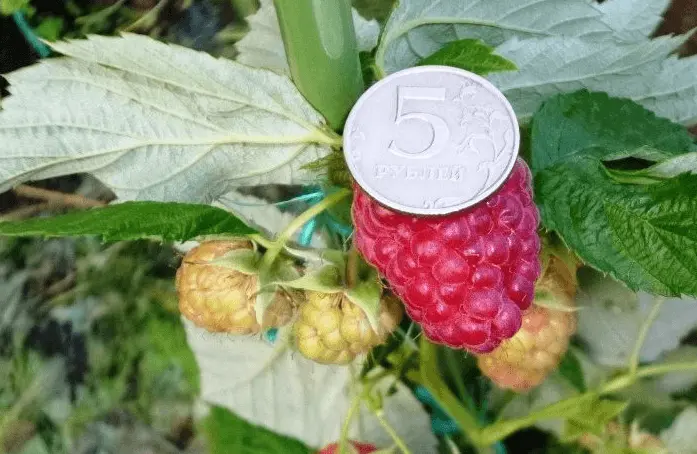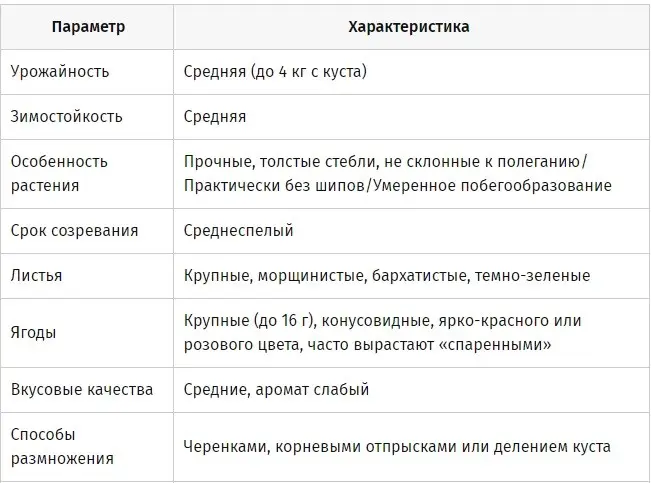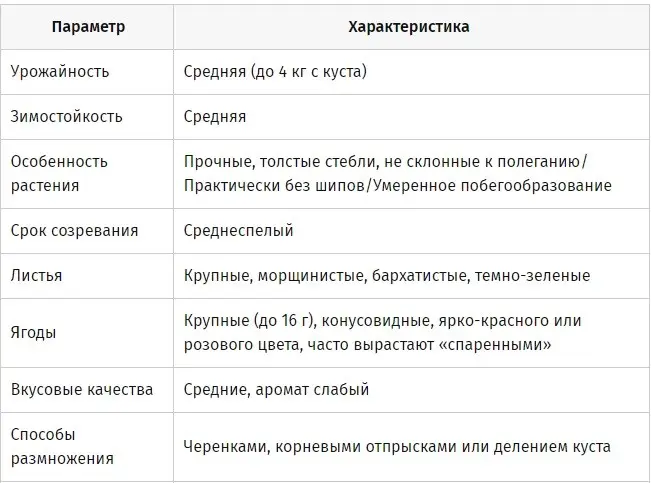Contents
Large-fruited raspberry Tarusa requires attention and special care. From our article today, you will learn how to achieve active fruiting and abundant yields of fruit and berry crops.
The origin of the standard variety
The large-fruited raspberry Tarusa was the result of a successful crossing of the cultivar Stolichnaya and the hybrid form of the Scottish selection Shtambovaya-1. The standard form obtained as a result of the experiment adopted almost all the positive characteristics of the “parents”. We are talking about high yields, excellent commercial qualities, resistance to diseases and weather phenomena characteristic of regions.
The author of the variety is Viktor Kichina, a well-known doctor of biological sciences among breeders. An experiment on breeding a standard variety was carried out in 1987. After 6 years, Tarusa raspberry seedlings became available for sale.
Video “Introduction to raspberry Tarusa”
This video presents the advantages and disadvantages of fruit and berry crops.
Characteristics of culture
The Tarusa variety differs from its “brothers” in the structure of the bush and the size of the berries. Shrubs are able to withstand frosts down to -25 ° C.
Description of the bush and berries
Tarusa – raspberry of a compressed standard variety. The average height of an adult bush is 1,5–1,7 m. At the same time, the lower part of the plant has no shoots. Branched shoots located in the upper part of the shrub form a dense tree-like crown.
The trunk and branches of the plant are painted light green. From above the bark is covered with a light wax coating. The leaves are heart-shaped. The edges of the leaf plates are torn. The outer side is painted in a bright green color, the inner – in a bluish-greenish. Veins are clearly visible on the inner surface of the leaf plate.
The peculiarity of the variety is large berries of high density with drupes. The average weight is 15-16 g, length – 5-7 cm. The fruits are characterized by a blunt conical shape, paired specimens are often found. The color ranges from deep red to deep ruby. The pulp is juicy and tender.

Fruiting and productivity
Raspberry Tarusa belongs to varieties of medium late ripening. Harvesting begins in mid-July and ends closer to the second decade of August.
Fruiting depends on the characteristics of the climatic zone of cultivation. In the southern regions, harvesting may begin 10-15 days earlier than the above period. In the northern regions, you can collect raspberries until the beginning of autumn.
One of the advantages of the Tarusa variety is its high yield. According to experienced gardeners, under favorable weather conditions, one bush gives at least 4 kg of berries. About 1 tons of large berries are harvested from 20 ha.
Taste and use of berries
Some gardeners note a pleasant sour-sweet taste and a characteristic raspberry aroma, others blame the variety for its weak taste. Such a controversial opinion is due to weather conditions. With an excess of moisture in the soil and an abundance of precipitation, a deterioration in the taste characteristics of fruits is observed.
If the berries are juicy and sweet, they are consumed fresh. Sour fruits are processed for the production of various drinks and desserts.

Advantages and disadvantages of the variety
Before buying a seedling, we recommend that you carefully study the advantages and disadvantages of the standard variety.
Advantages:
- active fruiting;
- high yield;
- large-fruited;
- good winter hardiness;
- lack of thorns on the shoots;
- versatility of the use of berries.
Disadvantages:
- bifurcation of fruits;
- abundant shoots;
- deterioration in the taste and commercial qualities of berries during heavy rainfall;
- low transportability and short storage of the harvested crop.
Agricultural machinery of the raspberry tree
The yield of grown cultivated plants is laid down at the stage of planting seedlings. An improperly selected planting site or poor-quality planting material can cause low fruiting and poor yields.
Features of landing
Growing raspberries begins with determining the timing and choosing a place for planting seedlings. Since the Tarusa variety is characterized by high survival rate, gardeners practice both spring and autumn planting of fruit and berry crops. Depending on the climatic features of the region, spring planting is carried out from late March to early April. If planting a raspberry tree is scheduled for autumn, then it is better to complete the procedure before the onset of cold weather. The optimal period is the first month of autumn.
For planting raspberry seedlings, we recommend looking at areas of the garden that are closed from the wind and drafts.
Author’s advice
Raspberries love the active sun and do not tolerate an abundance of shade. Sandy and loamy soils rich in organic matter are suitable for growing raspberry bushes. The acidity level is from 5,8 to 6,2 pH.
Raspberries do not tolerate the neighborhood with grapes, strawberries, tomatoes and potatoes. The neighborhood with marigolds, irises and nasturtium is undesirable. The best neighbors are apple, pear, plum, red and black currants, honeysuckle and barberry.
A landing pit measuring 50x50x40 cm is prepared in advance. A distance of 1–2 m is maintained between the holes. Drainage and fertilizers are laid at the bottom of the planting pit. To feed raspberries, you can use a mixture of rotted manure, wood ash, phosphate and potash fertilizers.
When planting a seedling, keep an eye on the root neck, which should be above the ground. Planted plants are watered abundantly along the edge of the near-stem circle and mulched.

Yield increase
Raspberries love moderate watering – about 1 time in 7-10 days. If the summer turned out to be rainy, the interval between waterings is increased. Under one adult bush, a bucket of water is required.
For abundant fruiting, standard raspberries should be fed periodically. Fertilizers can be applied according to the following scheme.

Bush shaping and tying
One of the obligatory stages of caring for standard raspberries is the formation of a bush. The first pinching is done when the bush reaches 1,6 m. The seedling is shortened by 10 cm. The next spring, the side shoots are shortened by 5–10 cm. At the end of the growing season, the fruiting branches are cut off to the very root.
Shrub pruning is carried out every autumn. Remove young shoots and weak shoots. Raspberry tree should have no more than 6-8 shoots.
A properly formed Tarusa raspberry bush does not require a garter. The trunk is self-supporting, strong shoots are not prone to falling off.
Preparation for winter
Raspberries grown in the southern and central regions can not be covered for the winter. But raspberry trees growing in the northern regions should be insulated. The stems are cleaned of leaves and bent to the ground. The collected bunch of branches is covered with spruce branches.
Common diseases and pests
The Tarusa variety is characterized by high resistance to bacterial and fungal diseases. But it suffers from aphids, crimson moth and crimson beetle invasions. Bordeaux liquid (1%) is used to prevent the appearance of parasites. The insecticide “Karbofos” will help get rid of pests.
Reviews of gardeners about raspberry Tarusa
“I have been growing Tarusa raspberries for over 5 years. Captivating lack of difficulties with landing and care. The only negative is the watering mode. The plant reacts negatively to both lack and excess of moisture in the soil.
“I boldly recommend the Tarusa variety to all gardeners. The shrub does not require shelter for the winter and quickly recovers with the advent of spring. Pleases with abundant yields, juicy and fragrant berries.
Raspberry Tarusa is often called controversial. The dependence of the taste of berries on the amount of moisture and precipitation makes one wonder. Stable fruiting and large-fruitedness, on the contrary, attract the attention of gardeners.









